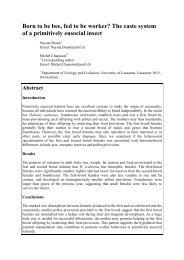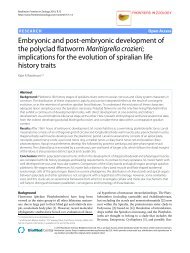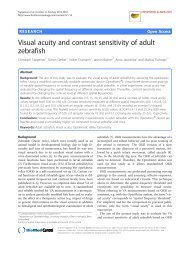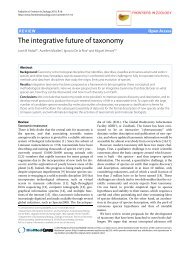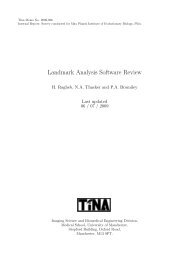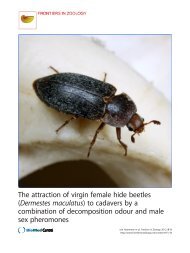Provisional PDF - Frontiers in Zoology
Provisional PDF - Frontiers in Zoology
Provisional PDF - Frontiers in Zoology
Create successful ePaper yourself
Turn your PDF publications into a flip-book with our unique Google optimized e-Paper software.
Menzel et al. <strong>Frontiers</strong> <strong>in</strong> <strong>Zoology</strong> 2013, 10:32 Page 12 of 12<br />
http://www.frontiers<strong>in</strong>zoology.com/content/10/1/32<br />
Chemical Ecology. Edited by Blomquist GJ, Bagnères A-G. Cambridge:<br />
Cambridge University Press; 2010:222–243.<br />
2. Vander Meer RK, Morel L: Nestmate Recognition <strong>in</strong> Ants. In Pheromone<br />
Communication <strong>in</strong> Social Insects Ants, Wasps, Bees, and Termites. Edited by<br />
Vander Meer RK, Breed MD, Espelie KE, W<strong>in</strong>ston ML. Boulder: Westview<br />
Press; 1998:79–103.<br />
3. Lenoir A, D’Ettorre P, Errard C, Hefetz A: Chemical ecology and social<br />
parasitism <strong>in</strong> ants. Annu Rev Entomol 2001, 46:573–599.<br />
4. Mori A, Visicchio R, Sledge MF, Grasso DA, Le Moli F, Turillazzi S, Spencer S,<br />
Jones GR: Behavioural assays test<strong>in</strong>g the appeasement allomone of<br />
Polyergus rufescens queens dur<strong>in</strong>g host-colony usurpation. Ethology<br />
Ecology and Evolution 2000, 12:315–322.<br />
5. Brandt M, He<strong>in</strong>ze J, Schmitt T, Foitzik S: Convergent evolution of the<br />
Dufour’s gland secretion as a propaganda substance <strong>in</strong> the slave-mak<strong>in</strong>g<br />
ant genera Protomognathus and Harpagoxenus. Insectes Sociaux 2006,<br />
53:291–299.<br />
6. Forel A: La parabiose chez les fourmis. Bullet<strong>in</strong> de la Societé vaudoise des<br />
Sciences Naturelles 1898, 34:380–384.<br />
7. Menzel F, Blüthgen N: Parabiotic associations between tropical ants:<br />
equal partnership or parasitic exploitation? J Anim Ecol 2010, 79:71–81.<br />
8. Vantaux A, Dejean A, Dor A, Orivel J: Parasitism versus mutualism <strong>in</strong> the<br />
ant-garden parabiosis between Camponotus femoratus and<br />
Crematogaster levior. Insectes Sociaux 2007, 54:95–99.<br />
9. Menzel F, L<strong>in</strong>senmair KE, Blüthgen N: Selective <strong>in</strong>terspecific tolerance <strong>in</strong><br />
tropical Crematogaster-Camponotus associations. Anim Behav 2008,<br />
75:837–846.<br />
10. Menzel F, Blüthgen N, Schmitt T: Tropical parabiotic ants: Highly unusual<br />
cuticular substances and low <strong>in</strong>terspecific discrim<strong>in</strong>ation. <strong>Frontiers</strong> <strong>in</strong><br />
<strong>Zoology</strong> 2008, 5:16.<br />
11. Menzel F, Schmitt T: Tolerance requires the right smell: first evidence for<br />
<strong>in</strong>terspecific selection on chemical recognition cues. Evolution 2011,<br />
66–3:896–904.<br />
12. D'Ettorre P, Lenoir A: Nestmate recognition. In Ant ecology. Edited by Lach<br />
L, Parr CL, Abbott KL. Oxford: Oxford University Press; 2010:194–209.<br />
13. Menzel F, Schmitt T, Blüthgen N: Intraspecific nestmate recognition <strong>in</strong> two<br />
parabiotic ant species: acquired recognition cues and low <strong>in</strong>ter-colony<br />
discrim<strong>in</strong>ation. Insectes Sociaux 2009, 56:251–260.<br />
14. Kühbandner S, Sperl<strong>in</strong>g S, Mori K, Ruther J: Decipher<strong>in</strong>g the signature of<br />
cuticular lipids with contact sex pheromone function <strong>in</strong> a parasitic wasp.<br />
J Exp Biol 2012, 215:2471–2478.<br />
15. Yew JY, Dreisewerd K, de Oliveira CC, Etges WJ: Male-specific transfer and<br />
f<strong>in</strong>e scale spatial differences of newly identified cuticular hydrocarbons<br />
and triacylglycerides <strong>in</strong> a Drosophila species pair. PLoS One 2011, 6:16898.<br />
16. Blomquist GJ, Bagnères A-G: Introduction: history and overview of <strong>in</strong>sect<br />
hydrocarbons. In Insect Hydrocarbons Biology, Biochemistry, and Chemical<br />
Ecology. Edited by Blomquist GJ, Bagnères A-G. Cambridge: Cambridge<br />
University Press; 2010:3–18.<br />
17. Buckner JS: Oxygenated derivatives of hydrocarbons. In Insect<br />
Hydrocarbons Biology, Biochemistry, and Chemical Ecology. Edited by<br />
Blomquist GJ, Bagnères A-G. Cambridge: Cambridge University Press;<br />
2010:187–203.<br />
18. Daloze D, de Biseau JC, Leclerq S, Braekman J-C, Qu<strong>in</strong>et Y, Pasteels JM:<br />
(13E,15E,18Z,20Z)-1-Hydroxypentacosa-13,15,18,20-tetraen-11-yn-4-one 1<br />
acetate, from the venom of a Brazilian Crematogaster ant. Tetrahedron<br />
Lett 1998, 39:4671–4672.<br />
19. Jones TH, Brunner SR, Edwards AA, Davidson DW, Snell<strong>in</strong>g RR: 6-<br />
Alkylsalicylic acids and 6-alkylresorcylic acids from ants <strong>in</strong> the genus<br />
Crematogaster from Brunei. J Chem Ecol 2005, 31:407–417.<br />
20. Laurent P, Hamdani A, Braekman JC, Daloze D, Isbell LA, de Biseau JC,<br />
Pasteels JM: New 1-alk(en)yl-1,3,5-trihydroxycyclohexanes from the<br />
Dufour gland of the African ant Crematogaster nigriceps. Tetrahedron Lett<br />
2003, 44:1383–1386.<br />
21. Leclerq S, Braekman JC, Kais<strong>in</strong> M, Daloze D: Venom constituents of three<br />
species of Crematogaster ants from Papua New Gu<strong>in</strong>ea. J Nat Prod 1997,<br />
60:1143–1147.<br />
22. Leclerq S, de Biseau JC, Braekman JC, Daloze D, Qu<strong>in</strong>et Y, Luhmer M,<br />
Sund<strong>in</strong> A, Pasteels JM: Furanocembranoid diterpenes as defensive<br />
compounds <strong>in</strong> the dufour gland of the ant Crematogaster brevisp<strong>in</strong>osa<br />
rochai. Tetrahedron 2000, 56:2037–2042.<br />
23. Leclerq S, de Biseau JC, Daloze D, Braekman J-C, Qu<strong>in</strong>et Y, Pasteels JM: Five<br />
new furanocembrenoids from the venom of the ant Crematogaster<br />
brevisp<strong>in</strong>osa ampla from Brazil. Tetrahedron Lett 2000, 41:633–637.<br />
24. Pasteels JM, Daloze D, Boeve JL: Aldehydic contact poisons and alarm<br />
pheromone of the ant Crematogaster scutellaris (Hymenoptera:<br />
Myrmic<strong>in</strong>ae) - enzyme mediated production from acetate precursors.<br />
Journal of Chemical Ecology 1989, 15:1501–1511.<br />
25. Laurent P, Braekman J-C, Daloze D, Pasteels JM: Biosynthesis of defensive<br />
compounds from beetles and ants. Eur J Organic Chem 2003,<br />
2003:2733–2743.<br />
26. Liebig J: Hydrocarbon profiles <strong>in</strong>dicate fertility and dom<strong>in</strong>ance status <strong>in</strong><br />
ant, bee, and wasp colonies. In Insect Hydrocarbons Biology, Biochemistry,<br />
and Chemical Ecology. Edited by Blomquist GJ, Bagnères A-G. Cambridge:<br />
Cambridge University Press; 2010:254–281.<br />
27. Kather R, Mart<strong>in</strong> SJ: Cuticular hydrocarbon profiles as a taxonomic tool:<br />
advantages, limitations and technical aspects. Physiological Entomology<br />
2012, 37:25–32.<br />
28. Thomas ML, Simmons LW: Sexual dimorphism <strong>in</strong> cuticular hydrocarbons<br />
of the Australian field cricket Teleogryllus oceanicus (Orthoptera:<br />
Gryllidae). J Insect Physiol 2008, 54:1081–1089.<br />
29. Vergoz V, Schreurs HA, Mercer AR: Queen pheromone blocks aversive<br />
learn<strong>in</strong>g <strong>in</strong> young worker bees. Science 2007, 317:384–386.<br />
30. Beggs KT, Glend<strong>in</strong><strong>in</strong>g KA, Marechal NM, Vergoz V, Nakamura I, Slessor KN,<br />
Mercer AR: Queen pheromone modulates bra<strong>in</strong> dopam<strong>in</strong>e function <strong>in</strong><br />
worker honey bees. Proc Natl Acad Sci USA 2007, 104:2460–2464.<br />
31. Dupuy F, Sandoz J-C, Giurfa M, Josens R: Individual olfactory learn<strong>in</strong>g <strong>in</strong><br />
Camponotus ants. Anim Behav 2006, 72:1081–1091.<br />
32. Mori A, Grasso DA, Visicchio R, Le Moli F: Colony found<strong>in</strong>g <strong>in</strong> Polyergus<br />
rufescens: the role of the Dufour’s gland. Insectes Sociaux 2000, 47:7–10.<br />
33. D’Ettorre P, Errard C, Ibarra F, Francke W, Hefetz A: Sneak <strong>in</strong> or repel your<br />
enemy: Dufour’s gland repellent as a strategy for successful usurpation<br />
<strong>in</strong> the slave-maker Polyergus rufescens. Chemoecology 2000, 10:135–142.<br />
34. Leonhardt SD, Jung L-M, Schmitt T, Blüthgen N: Terpenoids tame<br />
aggressors: role of chemicals <strong>in</strong> st<strong>in</strong>gless bee communal nest<strong>in</strong>g. Behav<br />
Ecol Sociobiol 2010, 64:1415–1423.<br />
35. Menzel F, Pokorny T, Blüthgen N, Schmitt T: Trail-shar<strong>in</strong>g among tropical<br />
ants: <strong>in</strong>terspecific use of trail pheromones? Ecological Entomology 2010,<br />
35:495–503.<br />
36. Menzel F, Staab M, Chung AYC, Gebauer G, Blüthgen N: Trophic ecology of<br />
parabiotic ants: Do the partners have similar food niches? Austral Ecol<br />
2012, 37:537–546.<br />
37. Edwards DP: The roles of tolerance <strong>in</strong> the evolution, ma<strong>in</strong>tenance and<br />
breakdown of mutualism. Naturwissenschaften 2009, 96:1137–1145.<br />
38. Thompson JN: Interaction and coevolution. New York: Wiley; 1982.<br />
39. Orivel J, Leroy C: The diversity and ecology of ant gardens (Hymenoptera:<br />
Formicidae; Spermatophyta: Angiospermae). Myrmecological News 2010,<br />
14:73–85.<br />
40. Menzel F: Mechanisms and adaptive significance of <strong>in</strong>terspecific<br />
associations between tropical ant species, PhDThesis.Würzburg:<br />
University of Würzburg; 2009.<br />
41. Pamm<strong>in</strong>ger T, Scharf I, Penn<strong>in</strong>gs P, Foitzik S: Increased host aggression<br />
as an <strong>in</strong>duced defence aga<strong>in</strong>st slavemak<strong>in</strong>g ants. Behav Ecol 2011,<br />
22:255–260.<br />
42. R Development Core Team: R: A language and environment for statistical<br />
comput<strong>in</strong>g. In R Foundation for Statistical Comput<strong>in</strong>g. 2131st edition.<br />
Vienna, Austria; 2011. http://www.r-project.org.<br />
doi:10.1186/1742-9994-10-32<br />
Cite this article as: Menzel et al.: Crematoenones – a novel substance<br />
class exhibited by ants functions as appeasement signal. <strong>Frontiers</strong> <strong>in</strong><br />
<strong>Zoology</strong> 2013 10:32.




